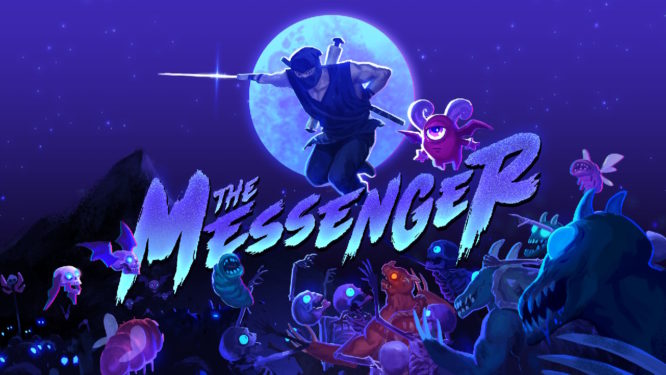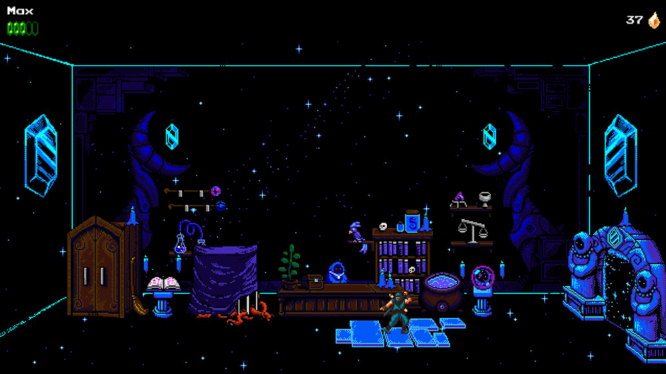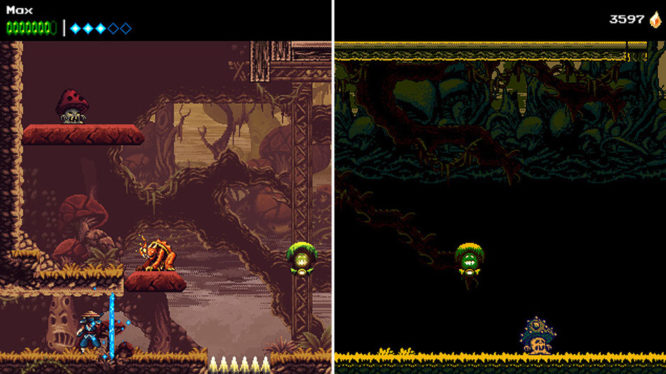
The Messenger is a game that cleverly fools players into thinking they’re playing a Ninja Gaiden inspired NES platformer. During the opening hours, you’ll be moving from level to level in a linear fashion, killing demonic enemies, picking up new abilities and beating giant bosses. Because of this, it’s easy to forget that you’re actually playing the first half of a time-twisting Metroidvania.

You play as a Ninja waiting for the return of the fabled “Western Hero”, who is prophesied to end the constant threat of an evil Demon Army. When the Army returns and attacks the Ninja Hideout all seems doomed until the Western Hero returns, entrusts you with an important magical scroll and gives you the task of carrying it to the top of a large mountain.
Given the title of ‘The Messenger’ you are then left to complete your task. The goal sounds simple enough, but the plot is really not as straightforward as it first seems.
Powering up
Like most platformers, The Messenger has you running and jumping to get around from A to B, however in this game you start the game with a fairly unique ability. By swinging your sword and hitting one of the games lantern-like objects you can perform an additional jump, called a “Cloudstep”. This move (which you’ll be using a lot) can be chained together to cover great distances. You can perform a Cloudstep off of any enemy or projectile too, which makes the game’s base movement pretty freeform and unlike anything I’d ever played before.
The Cloudstep is only the first ability that you unlock, you’ll find many more as you play through the game’s initial areas. Other abilities include a grappling hook that launches you towards objects and a wingsuit for riding pillars of air then gliding gently towards the ground, just to name a couple.
These abilities are not only required to continue on your journey, but they also come in handy finding secrets in earlier levels too. Whilst they form the crux of your character’s progression and improvement, they aren’t the only upgrades available to you as you play.
Checkpoints appear frequently throughout The Messenger and often double up as portals to the in-game shop. There aren’t any health potions or spares lives in stock here though. Instead, these act as a much-needed calling point for upgrading your skills. Run by a hooded shopkeeper, the multi-dimensional store is where you’ll finally able put those countless ‘time shards’ you’ve collected to good use. The upgrades are managed via a small skill tree and aren’t huge by any means. However, they do give you a slight edge by offering HP boosts, ranged attacks, and adjusting what items certain enemies may drop.

The Ninja’s challenge
Whilst I wouldn’t say The Messenger is a hard game, it does have its challenges. Death is not punished by the loss of a life, instead, there is a more unique forfeit. A character by the name of Quarble follows you around after each death, stealing any time shards you pick up for a short period of time. The games numerous checkpoints mean you rarely have to travel far to get back to where you fell, but there are still areas that will test your patience.
The bosses that end each level range from fairly easy to mildly frustrating. Just like any good boss battle the key to victory is learning their patterns and exploiting their moments of weakness for some quick damage. Some bosses reward you for using the mechanics of the game to your advantage. One example of this has a boss placed on a ledge just out of reach of your attacks, spawning enemies for you to deal with instead. By cloudstepping on these enemies in the right order to gain some altitude, it’s possible to knock the boss to the ground and stun her for a longer pummelling.
The game’s larger bosses are its best, hulking beasts that are equal parts terrain and enemy. These require you to stand on safe parts, whether it be their hands or shoulders, and attack the weak points.
Achieving 100% completion requires some patience, platforming prowess and some quick reactions. The game hides 45 power seals throughout the levels, and most of them are rewarded for completing a platforming challenge (usually with instant death as punishment for failure). These challenges can be pretty tough to find in the first place and there’s no way to find them all on your first run through each area. Later in the game, you unlock the ability to see each power seal on your map (which makes things a little easier). The reward for finding all 45 power seals was sadly not worth the effort for me, but it was still worth doing just to experience all the game had to offer.
A twisty, time-travelling tale
The Messenger introduces itself as a series of linear levels, with no way of travelling back to previous ones once you’ve advanced. However, all is not what it seems. Once the initial goals have been completed, the game then reveals itself as a Metroidvania in disguise, giving you access to every area you’ve already visited. You’re also now gifted with a map to see where you are, where you’ve been and what you may have missed.
Returning to old areas may remind you of a confusing obstacle you can now overcome, which will open up new sections that were suspiciously closed off before. You’ll also discover time portals are also dotted around the map, allowing you to swap between two time periods. You’re tasked with finding music notes scattered across the game’s map, but these collectables aren’t obviously signposted or too easy to find. There are a series of hints that you can choose to follow (or you can just buy the location if you’re genuinely stuck on a clue).

The time travelling mechanic has you swapping back and forth between the present and the future, which changes the level’s design. In the past whole areas of the map are blocked off, but in the future, you might not be able to use certain platforms. This adds an extra layer to the puzzles, and this is implemented better in the levels specifically created around this mechanic.
By the time you’ve reached the game’s mid-point, you begin to develop a sense of your character’s progression. You’ll be flying across rooms, decimating enemies and launching yourself across pits that would have been a challenge the first time you attempted them. It’s a shame then that your character doesn’t gain many new abilities from this point. The game spends the first few hours throwing new bosses and exciting upgrades at you during each level, but by the time you get to explore the map the upgrades dry up. A vast majority of the later upgrades are passive and they don’t add any new layers to the gameplay. New bosses are few and far between also.
Revisiting areas you’ve already explored is standard Metroidvania fare, but The Messenger’s biggest issue stems from the fact there are only a few new areas to discover. You spend most of your time traversing familiar ground with little reward. The game turns into a bit of a fetch quest to find the music notes, with the optional goal of collecting all the Power Seals. This is a tactic often used in games to pad out the final acts. Whilst the new levels and freedom to collect missed secrets do give you new goals and new content, it’s still mostly made up of areas and rooms you’ve seen before.
The game’s plot is entertaining (if a little confusing) at first. It has a fantastic, self-aware sense of humour that often breaks the fourth wall. The Shopkeeper character that you interact with throughout most of the game is full of hilarious dialogue and nihilistic tales that are a joy to discover. In fact, almost all of the characters you meet have something funny to say, which juxtaposes with the end-of-the-world dread and creates some genuinely hilarious moments. It’s worth checking in with the Shopkeeper as often as you can just to see everything he has to say.
Admittedly I do have a gripe with the plot’s final act. The game adds layers to the story as you play, building up your character’s role. It’s easy to think you’ve got the whole story pretty much worked out – that is until you’re just about to complete your quest. The final level of the game is preceded by a cutscene that, in my opinion, does nothing to enhance the story. Instead, it introduces characters that are somewhat unrelated to the journey you’ve just played through. To me, this felt disconnected from the overall tale and could have been woven into the story better, especially seeing as the ending had little to no foreshadowing or setup.
A ninja that should be seen and heard
The art style starts off being crafted around familiar 80’s nostalgia, but the 8-bit NES inspired graphics don’t ever quite reach the levels of some other contemporary throwback titles (at least until you get to some of the games larger bosses). This isn’t a fault with the game though, it’s most likely an intentional design choice. It’s not until you complete your linear run through of the games initial levels that you unlock the true beauty of The Messenger’s pixel art.
When your character completes his initial journey, the art style changes alongside it. The art goes from being an 8-bit homage to the NES games it’s emulating, to a glorious 16-bit art style in full colour, detail and gorgeous backdrops. Enemies feel more animated, the Ninja gets a new look (with a very cool hat) and it’s well worth taking in all the detail of the intricate pixel art. Levels that seemed dull (or even ugly) before are now reborn as awe-inspiring and visually pleasing landscapes. This gives a sense of freshness to a game that very soon becomes about re-treading familiar ground.
The game’s music is also affected by the leap in time, the 8-bit themes and sound effects get a modern 16-bit re-vamp, with more layers and different instruments. The soundtrack only has a few truly memorable songs, but each area in the game has its own signature song and it makes for pleasant background music. The first time I fell into a body of water and the music became muffled I had a genuine reaction of “wow, that was cool”.
Don’t shoot The Messenger
The Messenger’s linear first half has you waiting to be wowed by the world you’re itching to explore, but its choppy second doesn’t quite meet those expectations. Instead, the game turns what could have been an excellent and gorgeous 16-bit Metroidvania into a bit of a fetch quest. However, playing as the Ninja feels fantastic and the bosses are a delight to battle. Later challenges that utilise all of the game’s upgrades and game mechanics make for some intense moments. There is no reason for you to skip The Messenger. If you enjoyed similar throwback games like Shovel Knight or have an interest in platformers and Metroidvania games, there’s a lot to love here. It’s just a shame that once you’re free to explore the world as you see fit, you’ve already seen quite a lot of what it has to offer.






